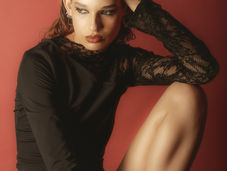Reviewing 'Boy Parts' at Soho Theatre: A Tale of Twisted Power Dynamics
- Sophie Cheung
- Dec 13, 2023
- 3 min read
Dark and morbidly funny, Eliza Clark’s novel, Boy Parts, created shockwaves when it was released in 2020. The story follows Irina Sturges, the self-obsessed, often cruel, and devious protagonist as she navigates her work as a photographer taking explicit photographs of average-looking men, building up to her collection of work to be shown in London. Running through November at Soho Theatre, Gillian Greer’s adaptation brought the anti-heroine protagonist to life, driving a feminist narrative that outlines twisted gender roles, power, and control in the art world.
The show opens with rolling credits and what appears to be a film shot by Irina. What follows are the events leading up to Irina’s exhibition in London, split into sections, each focusing on a different male model. Starting from a Jason Momoa lookalike named Will to an Eddie from Tesco, each of the men is violated under Irina’s gaze and her inner thoughts become more sinister. Eventually, Irina’s thoughts turn to violence and she is overcome with impulses to inflict pain upon her subjects, even as far as murder.

In a play that considers the idea of the gaze, Peter Butler’s set design is remarkably sparse–with only a wooden stool on stage. This draws our attention solely to Aimée Kelly’s solo performance, which she handles by expertly modulating her physicality and voice. From sassy and obnoxious to predatory and sultry, Kelly’s ability to form the distinct characters seen through Irina’s eyes solidifies our protagonist’s reputation as a manipulative and brilliantly unreliable narrator. As we follow the story, we know Irina as someone who enjoys being on the higher-ups of power in her relationships, whether it be with her best friend, Flo, or her morbid fascination with her models. At the heart of this tale of twisted power dynamics is Irina’s work. Her camera lens is exacting and captures exploitative and demeaning images–both with and without the consent of her male models, flipping the idea of the male gaze on its head.
Accompanying Kelly’s performance are the technical production elements and stage design which work in tandem to create an intense atmosphere. Christopher Nairne’s flashing lights combined with Tom Foskett-Barnes’ sound design delivers the striking resemblance of a camera shutter going off, plunging the audience headfirst into the world of Irina’s control. In terms of the stage itself, it is split with a large screen that spans across the stage, creating distinct spaces and vaguely resembling an old foldout Polaroid camera. Despite being a one-person show with a sparse set, the clever use of mixed media by Hayley Egan transforms the space into one that transcends place and time with the video clips, directing our gaze to Irina’s studio, recollections, and back to what is occurring on stage.
Throughout the story, we witness Irina become entangled in her power-hungry interactions and her slow descent into madness as her violent thoughts take over, blurring the lines between what’s real and fantasy. This ambiguous ending of whether or not Irina’s memories of murder are real is ultimately a testament to female frustration and control. Irina’s strength comes from her camera and what she can do with it, acting as her means of power in a field designed for her to have none.
Overall, Boy Parts is a psychological horror that subverts the male gaze and takes a sinister approach to female desire and power dynamics. When translated onto the stage, it is striking and sows chords of discomfort as the audience anticipates what’s to come next.
Edited by Georgia Gibson, Theatre Editor.
























Comments